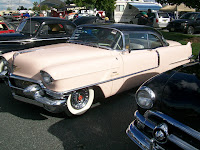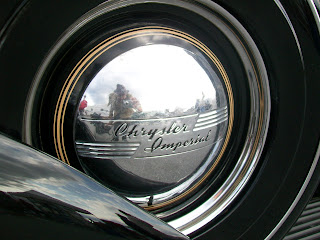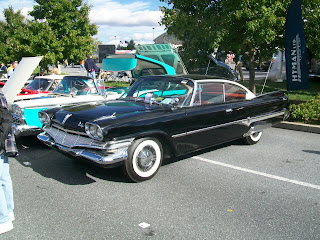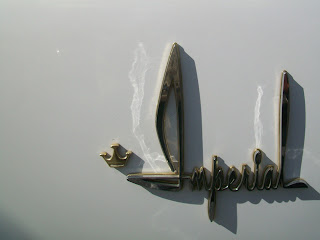"An Architect's most useful tools are an eraser at the drafting board and a wrecking bar at the site" Frank Lloyd Wright
Tuesday, November 27, 2012
Of Presidents and Emperors: a look at Lincoln Continental & Chrysler Imperial
I am not only a fan of mid (20th) century architecture, but of the history, design, culture, and film of the period. So I have decided to branch out from my blog’s initial focus, a specific look at architecture and widen that net to encompass other fields of artistic expression. Specifically I would like to share some of my passion for automotive design on this post. I went to the Hershey, PA Auto Show & Swap Meet this year and took tons of pictures of cars that moved me, rolling sculpture really. This post sort of grew around my favorites; Lincolns, Chryslers & Imperials, and a few other Forward Look Mopars(other Chrysler Corporation cars of the late 50's & early 60's.) I am a pretty big car nut, have been since as far back as I can remember, in fact as a toddler I entertained adults with my ability to name the kind of car they drove, I was particularly good at identifying a car by the wheel covers, the part of a car a small child sees up close pretty often. Unlike most car nuts I care not one bit about engines, power trains, or mechanicals. My love has always been for the shape, the design, the styling of the automobile. My favorite cars are luxury cars, the sleek, long, and elegant cruisers of the mid 50’s through the 70’s.
I have a fondness for some cars even through to the present day. The Chrysler 300 since 2005 has been my favorite contemporary car as it clearly recalls the great land yachts of old.
My interests often overlap and will lead to exposure to something from one area to another. For example, as a child my favorite cars were Continental Marks by the Lincoln Division of the Ford Motor Company. I found the spare tire motif of the deck lid especially distinctive, and it probably nurtured my love of sleek, long, and elegant luxury cars.
My history hobby over lapped with my car interest when I discovered the Lincoln Continental limousine associated with the administration of President Kennedy. Perhaps the historical interest reinforced a childhood predilection, at any rate I “fell” for the slab sided Lincoln Continentals of the 1960’s. Jacqueline Kennedy had a stunning 1960 Imperial Le Baron limousine for her use as first lady that would turn up in my Kennedy studies. The elegant black limo boasted gigantic fins, and an intriguing leather half roof. These cars were extremely rare having been hand built in Italy from Chrysler Corporation built body components in Detroit.
Pop-culture would reinforce and provide further exposure to things, after all not only President Kennedy rode around in Lincoln Convertibles, so did Oliver Wendell Douglas on Green Acres- another childhood favorite. And Milburn Drysdale on the Beverly Hillbillies was driven in an Imperial, Bruce Lee’s Kato and the Green Hornet’s Black Beauty was a custom Imperial and the only good thing about the recent remake. You can’t be exposed to the Kennedys, slab sided Lincolns and mid-century pop-culture without eventually coming across the incomparable Imperial.
It’s pretty much accepted that Cadillac was THE luxury car standard, but style and innovation leaders could be found at Ford and Chrysler. General Motors had a “branding” advantage in that no division of the company was burdened with the reputation of another division in the public consciousness. Most didn’t think of a Cadillac as a fancy Chevy.
Unfortunately the opposite was never the case with Ford and Chrysler, a consequence of the parent company sharing a name with a component division. Mercury was rarely thought of in the same league as Buick or even Chrysler, but more often as a “fancy Ford”, and indeed no longer exists. Ford has the Lincoln Division to ostensibly go up market but what with “platinum & titanium” editions and even the original 4 seater Thunderbird Ford has always been willing to cannibalize the up market potential of its “premium” brands. In the 1950’s however there seemed to be an agreement that GM’s success with its brand ladder was the strategy to copy. And for a brief time in the late 50’s you could nearly find a brand for brand matchup in all “big 3” lineups. For the “low priced three” you had Chevy, Ford, Plymouth, for the lower mid price market you had Pontiac, Edsel, Dodge, the mid price market found Oldsmobile, Mercury, & Desoto
the upper middle/lower upper price field would find Buick, a slightly demoted Lincoln, and Chrysler, and at the top of the market allegedly going toe to toe with Cadillac would be the new “Continental" and “Imperial” divisions. These lineups wouldn’t survive the early 60’s, which by then would see the end of the De Soto (61), Edsel (60), & Continental (57, but would live as a nameplate through 1960) divisions. Continental division was spun off of Lincoln, the original Lincoln Continental having started as a custom cabriolet for Edsel Ford's vacation. It was rumored to be so popular among Edsel's wealthy Palm Beach contemporaries that it was put into limited practically handbuilt production. (1940-1942, 1946-1948) It was this first Continental that was the inspiration for the Continental Mark II a mid 50’s masterpiece of elegance and restraint at a time famous for outlandish aerospace inspired rolling jukeboxes.(Equally loved by yours truly) It was hoped that this new Continental might be the first step in establishing a premium luxury brand for the Ford Motor Company.
The standard Lincoln was no slouch, and was historically among the finest cars in America, but by the early 50’s in size and content had been pushed downward into near Buick territory. But the Continental was not given enough time to develop into a credible luxury division and was reabsorbed into Lincoln after only 2 seasons (1956 & 1957) and approximately 3000 cars. They were nearly 10,000 dollar cars at a time when a Cadillac was about half as much.
Chrysler had similar aspirations when they spun off their top of the line Imperial model into its own make for 1955. The Imperial had been the finest model available in the Chrysler lineup for many years.
A Chrysler was a fine automobile, its namesake founder had successfully run the Buick division for General Motors before setting out to develop his own well built, luxurious, yet affordable car. He would reorganize the struggling Maxwell into the new Chrysler Corporation.
Chrysler division was meant to be an affordable aspirational car, probably equivalent to a Buick, and would develop the Plymouth as an entry level mass market car and the DeSoto for the mid priced field before acquiring Dodge.
They faced a somewhat similar problem as Ford in trying to craft a make out of a model. But whereas the Continental division was short-lived and ultimately reabsorbed into Lincoln division resulting in the legendary Lincoln Continental of the 1960’s, the Imperial would struggle to establish itself for 20 years before being dissolved, and largely forgotten, Although there have been 2 attempts to re-launch the Imperial as a premium Chrysler and both attempts have failed.
Even the storied Lincoln Continental nameplate disappeared early this century, and Lincoln struggles in the current luxury market while Chrysler has a somewhat successful niche as a luxury oriented aspirational mid priced car line.
Most people never recognized the independence of the Imperial line, and it was commonly referred to as “Chrysler-Imperial”.
Much in the same way that people call Continental Marks of the 70’s through the early 80’s “Lincoln Continental Marks” even though they never said “Lincoln” on them, after all they were sold alongside “Lincoln Continentals” in Lincoln-Mercury Dealers, but such is the way things are in the world of automotive nomenclature. And I think it is much preferable to the alphabet soup of the present day “MKZ, MKS, etc.”. The Imperial was a distinctive, powerful, well engineered car, if not always well-built. Sales were never terribly high, although they did surpass Lincoln briefly in the late 50’s before Lincoln Continental seized the number 2 spot in the luxury market.
Imperials have several distinctive traits among their 20 years of independent marketing, the earliest cars are known for freestanding taillights, or taillights integrated with oversized flamboyant tailfins. In fact the quintessential Cadillac the outlandish 1959 Cadillac with its enormous fins and twin rocket pod taillights can be clearly read as a reaction against the 1957 Imperial. That the mighty Cadillac felt the need with its enormous production numbers to answer the challenge of the Imperial with its meager sales says a lot about the real style leader.
But it was of little consolation to the slow selling Imperial, which would end up following Lincolns slab side lead in 1964. The 1964 Imperial is largely a riff on the stunning 1961 Lincoln Continental, and it was designed by the same man, Elwood Engel.
Passed over for the head of styling at Ford on the heels of the exquisite Continental, Elwood ended up at Chrysler. Chrysler having set the tone for the late 50’s with its long low rakish designs and daring fins under the design of Virgil Exner , had stayed at the party too long, and Elwood was brought in to replace Exner and apply his signature shear, slab sided corner filled out design language to the entire Chrysler Corporation line. This “corner filled out” look would be the hallmark of all subsequent Imperials.
Virgil Exner deserved better, he came along when Chrysler was dead last in the looks department and reinvigorated the stodgy cars with style and flair. Introduced gradually starting in 1955 Exner’s design language was called the “Forward Look”. It generally gave the cars a lower wedge like profile, with canted fronts and ends to denote motion.
Fins visually lifted the rears of the cars, each make in the Chrysler Corporation was given a signature fin, and the motif was developed over several years.
The Imperial trademark was daring fins with distinctive freestanding taillights, in some cases integrated with the fin or suspended or mounted on the fin. Sales followed across the line especially in 1957, unfortunately the production side of things was neglected and quality control was so bad that so many customers won over by the daringly beautiful cars were turned off by the horribly put together machines
Exner would end up taking too much blame for things out of his control. Imperial never managed too many sales, perhaps there wasn’t enough distinction between the standard Chrysler line to justify the price premium. And although they were feature laden cars that performed superbly they lacked the prestige of other luxury cars, limiting their “snob appeal”. They have amazing attention to design detail, each medallion on the car is a mid-century work of art as is the script work on the name plates. The freestanding headlights are meant to recall classic automobiles of the 1930’s, and are suberb examples of retrofuturism.
GM always had more sales, and I have soft spots for Oldsmobile and Buick but I have always thought that there were many more unique cars to be found at Ford and Chrysler. The famous Eldorado of 1967 owes more to the Continental Mark II than anything at GM. And the 59 GM lineup is an attempt to marry Exner’s finned Forward Look with the jet bomber bulbous motifs that were GM trademarks in the 50’s. The shear coke bottle look that was established by GM in the 60’s owes a lot to the slab sides and rear hop-up of the 61 Lincoln Continental. I was such a “Lincoln man” for many years I had a hard time fully embracing the Imperial, in fact my first car was a 1964 Lincoln Continental, and I also owned a 1969 Continental Mark III, and 87 and 96 Town Cars. But something about the quirky styling has called to the googie lover in me. The 57-62 Imperials really do have an out there retrofuturistic quality that I think is more Saarinen and Lautner-ish than say the Bauhaus feel of a 61 Lincoln Continental, and the 64-68 Imperials are Danish modern on wheels. So in many ways the Imperial won me over, much in the way the Populuxe/Googie style inspires me. I have never owned an Imperial, I came close but then the owner decided not to sell. It was a 67 Imperial Le Baron, and if the interior could have been sold on ebay they would have said “Eames L@@K!”, the seats looked like Eames chairs and the dashboard was like a Danish modern hi-fi cabinet. I have since owned a Chrysler LHS and a PT Cruiser, and I like them, but then they are more aspirational mid priced cars than true luxury cars and that was largely what did the Imperial in, they none the less have a bit of that American style that made Chryslers and Imperials so special.
Subscribe to:
Post Comments (Atom)





























No comments:
Post a Comment